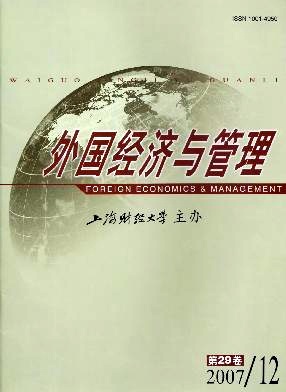多重理论视角下的组织适应性分析
外国经济与管理 2007 年 第 29 卷第 12 期, 页码:56 - 64
摘要
参考文献
摘要
近年来,组织环境和组织行为日趋复杂,组织适应性已成为组织理论研究领域备受重视的课题。其研究跨越了社会学、生物学、管理学及复杂科学等多个领域,形成了众多的理论观点。这些观点之间既存在相同的含义也有各自独特的所指。本文对不同视角下的相关理论观点进行了综述,以期为组织变革实践提供理论指导。
[1]Filstad,C.How newcomer use role models in organizational socialization[J].Journal of Workplace Learning,2004,16(7):396-409.
[2]Irene,Hau-Siu Chow.Organizational socialization and career success of Asian man agrees[J].The International Journal of HumanResource Management,2002,13(4):720-737.
[3]Swiercz,P M,McHugh,P,and Goldberg,C.Human resource systems for competitive advantage[M].MA:Simon&Schuster Cus-tom Publishing,1997.
[4]Harman,M T,and Carroll,G R.Dynamics of organizational populations:Density,legitimation,and competition[M].New York:Oxford University Press,1992.
[5]Kauffman,S A.The origins of order:Self-organization and selection in evolution[M].New York:Oxford University Press,1993.
[6]McKelvey,B.Avoiding complexity catastrophe in coevolutionary pockets:Strategies for rugged landscapes[J].Organization Science,1999,10(3):294-321.
[7]Kogut,B,and Zander,U.A memoir and reflection:Knowledge and an evolutionary theory of the multinational firm 10 years later[J].Journal of International Business Studies,2003,34:505-515.
[8]Henderson,A D,and Stern,I.Selection-based learning:The coevolution of internal and external selection in high-velocity environ-ment[J].Administrative Science Quarterly,2004,49:39-75.
[9]Branzei,O,et al.The formation of green strategies in Chinese firms:Matching corporate environmental responses and individualprinciples[J].Strategic Management Journal,2004,25:1 075-1 095.
[10]Grant,R M.Toward a knowledge-based theory of the firm[J].Strategic Management Journal,1996,17(Win.Spe.Iss.):109-122.
[11]Terwiesch,C,and Bohn,R E.Learning and process i mprovement during production ramp-up[J].International Journal of Produc-tion Economics,2001,70:1-19.
[12]Cockburn,I M,Henderson,R M,and Stern,S.Untangling the origins of competitive advantage[J].Strategic Management Jour-nal,2000,21:1 123-1 145.
[13]Lovas,B,and Ghpshal,S.Strategy as guided evolution[J].Strategic Management Journal,2000,21:875-896.
[14]Park,S H,and Zhou,D.Firmheterogeneity and competitive dynamicsin alliance formation[J].Academy of Management Review,2005,30:531-554.
[15]Macintosh,R,and MacLean,D.Conditioned emergence:Adissipative structures approachto transformation[J].Strategic Manage-ment Journal,1999,20:297-316.
[16]Chiles,T H,Meyer,A D,and Hench,TJ.Organizational emergence:The origin and transformation of Branson,Missouris musicaltheaters[J].Organization Science,2004,15(5):499-519.
[17]Boisot,M,and Child,J.Organizations as adaptive systemsin complex environments:The cases of China[J].Organization Science,1999,10:237-252.
[18]Kauff man,S A.At homeinthe universe:The searchfor thelaws of self-organization and complexity[M].New York:Oxford Uni-versity Press,1995.
[19]Robertson,D A.The complexity of the corporation[J].Human Systems Management,2004,23:71-78.
[20]Laverty,KJ.Managerial myopia or systemic short-tremism[J].Management Decision,2004,42(8):949-962.
[2]Irene,Hau-Siu Chow.Organizational socialization and career success of Asian man agrees[J].The International Journal of HumanResource Management,2002,13(4):720-737.
[3]Swiercz,P M,McHugh,P,and Goldberg,C.Human resource systems for competitive advantage[M].MA:Simon&Schuster Cus-tom Publishing,1997.
[4]Harman,M T,and Carroll,G R.Dynamics of organizational populations:Density,legitimation,and competition[M].New York:Oxford University Press,1992.
[5]Kauffman,S A.The origins of order:Self-organization and selection in evolution[M].New York:Oxford University Press,1993.
[6]McKelvey,B.Avoiding complexity catastrophe in coevolutionary pockets:Strategies for rugged landscapes[J].Organization Science,1999,10(3):294-321.
[7]Kogut,B,and Zander,U.A memoir and reflection:Knowledge and an evolutionary theory of the multinational firm 10 years later[J].Journal of International Business Studies,2003,34:505-515.
[8]Henderson,A D,and Stern,I.Selection-based learning:The coevolution of internal and external selection in high-velocity environ-ment[J].Administrative Science Quarterly,2004,49:39-75.
[9]Branzei,O,et al.The formation of green strategies in Chinese firms:Matching corporate environmental responses and individualprinciples[J].Strategic Management Journal,2004,25:1 075-1 095.
[10]Grant,R M.Toward a knowledge-based theory of the firm[J].Strategic Management Journal,1996,17(Win.Spe.Iss.):109-122.
[11]Terwiesch,C,and Bohn,R E.Learning and process i mprovement during production ramp-up[J].International Journal of Produc-tion Economics,2001,70:1-19.
[12]Cockburn,I M,Henderson,R M,and Stern,S.Untangling the origins of competitive advantage[J].Strategic Management Jour-nal,2000,21:1 123-1 145.
[13]Lovas,B,and Ghpshal,S.Strategy as guided evolution[J].Strategic Management Journal,2000,21:875-896.
[14]Park,S H,and Zhou,D.Firmheterogeneity and competitive dynamicsin alliance formation[J].Academy of Management Review,2005,30:531-554.
[15]Macintosh,R,and MacLean,D.Conditioned emergence:Adissipative structures approachto transformation[J].Strategic Manage-ment Journal,1999,20:297-316.
[16]Chiles,T H,Meyer,A D,and Hench,TJ.Organizational emergence:The origin and transformation of Branson,Missouris musicaltheaters[J].Organization Science,2004,15(5):499-519.
[17]Boisot,M,and Child,J.Organizations as adaptive systemsin complex environments:The cases of China[J].Organization Science,1999,10:237-252.
[18]Kauff man,S A.At homeinthe universe:The searchfor thelaws of self-organization and complexity[M].New York:Oxford Uni-versity Press,1995.
[19]Robertson,D A.The complexity of the corporation[J].Human Systems Management,2004,23:71-78.
[20]Laverty,KJ.Managerial myopia or systemic short-tremism[J].Management Decision,2004,42(8):949-962.
引用本文
吕鸿江, 刘洪, 程明. 多重理论视角下的组织适应性分析[J]. 外国经济与管理, 2007, 29(12): 56–64.
导出参考文献,格式为:
上一篇:工作生活质量研究述评与展望





 6070
6070  877
877

